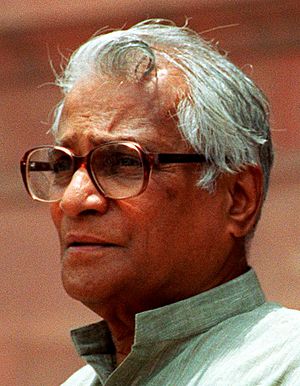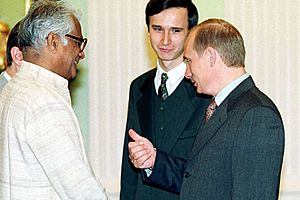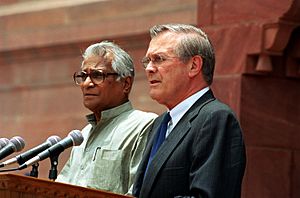George Fernandes facts for kids
Quick facts for kids
George Fernandes
|
|
|---|---|

George Fernandes in 2002
|
|
| 22nd Minister of Defence | |
| In office 21 October 2001 – 22 May 2004 |
|
| Prime Minister | Atal Bihari Vajpayee |
| Preceded by | Jaswant Singh |
| Succeeded by | Pranab Mukherjee |
| In office 19 March 1998 – 16 March 2001 |
|
| Prime Minister | Atal Bihari Vajpayee |
| Preceded by | Mulayam Singh Yadav |
| Succeeded by | Jaswant Singh |
| Minister of Railways | |
| In office 2 December 1989 – 10 November 1990 |
|
| Prime Minister | V. P. Singh |
| Preceded by | Madhav Rao Scindia |
| Succeeded by | Janeshwar Mishra |
| Member of Parliament, Rajya Sabha for Bihar | |
| In office 4 August 2009 – 7 July 2010 |
|
| Member of Parliament, Lok Sabha | |
| In office 2004–2009 |
|
| Preceded by | Jai Narain Prasad Nishad |
| Succeeded by | Jai Narain Prasad Nishad |
| In office 1989–1996 |
|
| Preceded by | Laliteshwar Prasad Shahi |
| Succeeded by | Jai Narain Prasad Nishad |
| In office 1977–1984 |
|
| Preceded by | Nawal Kishore Sinha |
| Succeeded by | Laliteshwar Prasad Shahi |
| Constituency | Muzaffarpur, Bihar |
| In office 1996–2004 |
|
| Preceded by | Vijay Kumar Yadav |
| Succeeded by | Nitish Kumar |
| Constituency | Nalanda, Bihar |
| In office 1967–1971 |
|
| Preceded by | Sadashiv Kanoji Patil |
| Succeeded by | Kailas Narain Narula Shivnarain |
| Constituency | Mumbai South, Maharashtra |
| Personal details | |
| Born |
George Mathew Fernandes
3 June 1930 Mangalore, Madras Presidency, British India (present-day Mangaluru, Karnataka, India) |
| Died | 29 January 2019 (aged 88) New Delhi, India |
| Political party | Samata Party |
| Other political affiliations |
|
| Spouse | Leila Kabir |
| Children | 1 son |
| Residences | Bangalore, Karnataka, India |
| Awards | Padma Vibhushan (2020) (posthumously) |
| Signature | |
| Source: [1] | |
George Mathew Fernandes (born June 3, 1930 – died January 29, 2019) was an important Indian leader. He was a trade union leader, a statesman (a skilled politician), and a journalist. He served as India's 22nd Defence Minister from 1998 to 2004.
He was a member of the Lok Sabha (India's main Parliament house) for over 30 years. He started in Mumbai in 1967 and mostly represented areas in Bihar. George Fernandes was a key member of the Janata Dal party. He also started the Samata Party. He held many important jobs in the government, like looking after communications, industry, railways, and defence. In 2020, after he passed away, he received the Padma Vibhushan. This is India's second highest award for civilians.
Contents
George Fernandes: Early Life & Activism
George Fernandes was born in Mangalore on June 3, 1930. His family was Mangalorean Catholic. He was the oldest of six brothers. His mother named him George after King George V, who was also born on June 3.
Becoming a Priest & Changing Paths
When he was 16, George went to a seminary in Bangalore. This was a school to train as a Roman Catholic priest. He studied there for about two and a half years. But he soon felt disappointed. He noticed that the leaders ate better food than the students. At 19, he decided to leave the seminary. He later said he was "disillusioned" because the Church did not always practice what it preached.
Starting Work for Workers
After leaving the seminary, George Fernandes started working. He organized workers in hotels and transport in Mangalore. He also tried working as an insurance agent. His first mentor was Ammembala Balappa, a freedom fighter. Balappa helped George gather hotel workers and other laborers. George joined the Praja Socialist Party in Mangalore.
In 1949, he led one of Mangalore's first labor strikes. The police broke up the strike. After this, George met Placid D’Mello, a famous trade union leader from Mumbai.
Moving to Mumbai and Becoming a Union Leader
In 1949, George moved to Bombay to find work. Life was hard at first. He sometimes slept on the streets. He got a job as a proofreader for a newspaper. He met Placid D’Mello again and also Rammanohar Lohia, who greatly influenced him.
He joined the socialist trade union movement. He became well-known for fighting for the rights of workers. He helped workers in small industries like hotels and restaurants. In the 1950s, he became a key figure in the Mumbai labor movement. He helped many workers form unions.
Fighting for Dock Workers' Rights
In 1951, Fernandes joined the Bombay Dock Worker's Union. He helped restart their newsletter, The Dockman. When Placid D’Mello was arrested in 1951, George organized a march. About 200 dock workers walked from Mumbai to Pune to meet the Chief Minister. They wanted D’Mello to be released.
As a labor organizer, George was often jailed. This happened when workers fought with company thugs. He was also a member of the Bombay Municipal Corporation from 1961 to 1968. He always spoke up for exploited workers in the city.
In 1961, on his first day at the Corporation, he asked for meetings to be in Marathi instead of English language. He was arrested in 1963 for demanding changes to taxi fares. He was jailed but later released after a big rally for him in Mumbai.
Entering Politics: The "Giant-killer"
George Fernandes became very famous when he ran in the 1967 Indian general election. He ran for the Samyukta Socialist Party in the Bombay South area. He was up against S. K. Patil, a very experienced politician from the Indian National Congress.
Even though Patil was well-known, Fernandes won! He got almost half of all the votes. This big win earned him the nickname "George the Giant-killer." Patil's political career ended after this defeat. In 1969, George became the General Secretary of the Samyukta Socialist Party. In 1973, he became the Chairman of the Socialist Party.
George Fernandes: A Leader for Change
George Fernandes was known for organizing big strikes. He fought for workers' rights.
The 1974 Railway Strike
His most famous strike was the All India Railway strike in 1974. At that time, he was the President of the All India Railwaymen's Federation. This strike brought the entire country to a halt. Railway workers had many complaints that had built up over 20 years.
In February 1974, different railway unions and political parties came together. They formed a committee to prepare for a strike. The strike began on May 8, 1974. In Mumbai, electricity workers, transport workers, and taxi drivers joined the protests. Across India, many protests happened.
The government reacted strongly to the strike. Many people were arrested. Amnesty International reported that 30,000 trade union members were held. The strike was called off on May 27, 1974. George Fernandes was released, but thousands of others remained in jail. This strike made the government feel insecure. It led to Indira Gandhi declaring the Emergency in 1975.
The Emergency Era and His Fight for Rights
On June 25, 1975, Prime Minister Indira Gandhi declared a state of emergency. This meant that many basic rights in India were suspended. People who spoke against the government, like political opponents and journalists, were jailed. George Fernandes strongly opposed this. He saw it as a wrong use of power.
A warrant was issued for his arrest. George went into hiding to avoid being caught. When the police could not find him, they arrested his brother, Lawrence Fernandes. They tried to make his brother tell them where George was. Snehalata Reddy, who was in touch with George, was also arrested. She was not given proper care in prison and died soon after her release.
George Fernandes continued to challenge the government. He was finally arrested in Calcutta on June 10, 1976. He was accused of planning to disrupt government operations to protest the Emergency. After his arrest, Amnesty International asked the government to let him see a lawyer. Leaders from Germany, Norway, and Austria also warned Indira Gandhi not to harm him.
Becoming a Union Minister
The Emergency ended in January 1977. Elections were held in March 1977. The Congress Party, led by Indira Gandhi, lost. The Janata Party, a group of parties that opposed the Emergency, won.
The Janata Party formed the government. Morarji Desai became the first Prime Minister who was not from the Congress Party. George Fernandes won his seat in Muzaffarpur, Bihar, by a huge number of votes. He won even though he was still in jail and had not visited the area. He was made the Union Minister for Industries.
As minister, he made sure foreign companies like IBM and Coca-Cola followed Indian rules. These rules said foreign investors could not own more than 40 percent of Indian companies. When Fernandes insisted on these rules, the two companies decided to leave India.
During his time as MP, Fernandes helped set up a TV station (Doordarshan Kendra) and a power plant (Kanti Thermal Power Station) in Muzaffarpur. He also helped start a Lijjat papad factory. These projects created jobs for people in Muzaffarpur. He also strongly supported women's empowerment. In 2014, the Kanti Thermal Power Station was renamed after him.
George Fernandes: Later Political Roles
George Fernandes continued to be active in politics. He was part of different political parties.
Railway Minister and Konkan Railway

In 1989, George Fernandes became the Minister of Railways again. This was under the government of V. P. Singh. Even though his term was short, it was very important. He was a main force behind the Konkan Railway project. This was the first big railway development in India since it became independent.
Fernandes later left the Janata Dal party. He formed the Samata Party in 1994. This party worked closely with the Bharatiya Janata Party (BJP). The BJP and its allies formed a government in 1996, but it only lasted 13 days. Fernandes then served in the opposition.
In 1999, the BJP and its allies formed a group called the National Democratic Alliance (NDA). This was the first non-Congress government to complete a full five-year term (1999–2004). Fernandes became a key leader in the NDA. In 2003, he rejoined the Janata Dal (United) party, merging his Samata Party with it.
Defence Minister During Kargil War
George Fernandes served as India's Defence Minister from 1998 to 2004. During this time, the Kargil War broke out between India and Pakistan in 1999. The war started when armed intruders from Pakistan took over high areas in Kargil. They attacked a key highway. The Indian Army launched "Operation Vijay" to push them back.
In May 1998, India conducted five nuclear tests in Pokhran, Rajasthan. George Fernandes, who had once supported stopping nuclear weapons, now openly supported India's decision to test these bombs. He also visited the Siachen Glacier 18 times. This glacier in Kashmir is known as "the world's highest battlefield." He also oversaw a large increase in India's defence budget.
After Being Defence Minister
The NDA government lost power in the 2004 elections. George Fernandes continued his political work. In 2009, he ran for election as an independent candidate but lost. Later that year, he was elected to the Rajya Sabha (another house of Parliament) without opposition. He was sworn in on August 4, 2009.
Writings and Personal Life
George Fernandes enjoyed writing and journalism. In 1949, he edited a Konkani language monthly magazine called Konkani Yuvak. He also edited a Kannada weekly called Raithavani. He helped restart The Dockman weekly in English.
He wrote several books about politics. These included What Ails the Socialists and his autobiography, George Fernandes Speaks. He was also the editor of an English monthly, The Other Side. As a human rights activist, he was a member of Amnesty International.
Family and Languages
Fernandes met Leila Kabir, the daughter of a former minister, on a flight. They married on July 22, 1971. They had one son, Sean Fernandes. George and Leila separated in the mid-1980s.
George Fernandes could speak ten languages! His mother tongue was Konkani. He also spoke English, Hindi, Tulu, Kannada, Marathi, Tamil, Urdu, Malayalam, and Latin. He learned Marathi and Urdu while in jail. He learned Latin when he was studying to be a priest.
In his later years, George Fernandes suffered from Alzheimer's disease and Parkinson's disease. He passed away on January 29, 2019, at the age of 88, in Delhi. He had a swine flu infection. The 14th Dalai Lama wrote a condolence letter, praising George Fernandes as a "great humanitarian" and a "voice to millions of poor and needy people." He also said Fernandes was a steady friend to the Tibetan cause.
Images for kids
See also
 In Spanish: George Fernandes para niños
In Spanish: George Fernandes para niños


